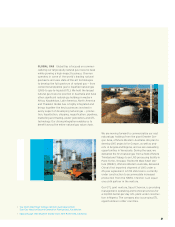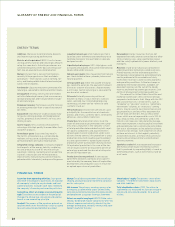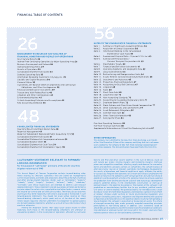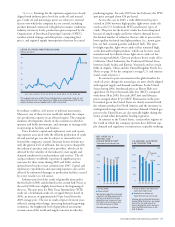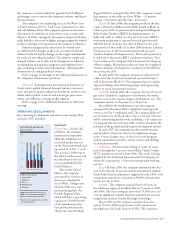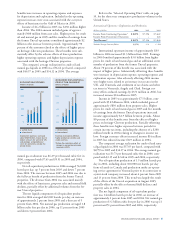Chevron 2006 Annual Report Download - page 26
Download and view the complete annual report
Please find page 26 of the 2006 Chevron annual report below. You can navigate through the pages in the report by either clicking on the pages listed below, or by using the keyword search tool below to find specific information within the annual report.
GLOSSARY OF ENERGY AND FINANCIAL TERMS
Additives Chemicals to control engine deposits
and improve lubricating performance.
Barrels of oil-equivalent (BOE) A unit of meas-
ure to quantify crude oil and natural gas amounts
using the same basis. Natural gas volumes are
converted to barrels on the basis of energy con-
tent. See oil-equivalent gas and production.
Biofuel Any fuel that is derived from biomass —
recently living organisms or their metabolic
byproducts — from sources such as farming, for-
estry, and biodegradable industrial and municipal
waste. See renewables.
Condensate Liquid hydrocarbons pro duced with
natural gas, separated by cooling and other means.
Development Drilling, construction and related
activities following discovery that are necessary
to begin production and transportation of crude
oil and natural gas.
Enhanced recovery Techniques used to increase
or prolong production from crude oil and natural
gas fields.
Exploration Searching for crude oil and/or natu-
ral gas by utilizing geologic and topographical
studies, geophysical and seismic surveys, and
drilling of wells.
Gas-to-liquids (GTL) A process that converts
natural gas into high-quality transportation fuels
and other products.
Greenhouse gases Gases that trap heat in
the Earth’s atmosphere (e.g., carbon dioxide,
methane, nitrous oxide, hydrofluorocarbons,
perfluorocarbons and sulfur hexafluoride).
Integrated energy company A company en gaged
in all aspects of the energy industry: exploring
for and producing crude oil and natural gas
(upstream); refining, marketing and transporting
crude oil, natural gas and refined products
(downstream); manufacturing and distributing
petrochemicals (chemicals); and generating power.
Liquefied natural gas (LNG) Natural gas that is
liquefied under extremely cold temperatures to
facilitate storage or transportation in specially
designed vessels.
Liquefied petroleum gas (LPG) Light gases, such
as butane and propane, that can be maintained as
liquids while under pressure.
Natural gas liquids (NGL) Separated from natural
gas, these include ethane, propane, butane and
natural gasoline.
Oil-equivalent gas (OEG) The volume of natural
gas needed to generate the equivalent amount
of heat as a barrel of crude oil. Approximately
6,000 cubic feet of natural gas is equivalent to
one barrel of crude oil.
Oil sands Naturally occurring mixture of
bitumen (a heavy, viscous form of crude oil),
water, sand and clay. Using hydroprocessing
technology, bitumen can be refined to yield
synthetic crude oil.
Petrochemicals Derived from petro leum; used
principally for the manufacture of chemicals,
plastics and resins, synthetic fibers, detergents,
adhesives, and synthetic motor oils.
Production Total production refers to all the
crude oil and natural gas produced from a prop-
erty. Gross production is the company’s share
of total production before deducting both royal-
ties paid to landowners and a government’s
agreed-upon share of production under a pro-
duction-sharing contract. Net production is gross
production minus both royalties paid to landown-
ers and a government’s agreed-upon share of
production under a production-sharing contract.
Oil-equivalent production is the sum of the bar-
rels of liquids and the oil-equivalent barrels of
natural gas produced. See barrels of oil-equiva-
lent and oil-equivalent gas.
Production-sharing contract A contractual
agreement between a company and a govern-
ment whereby the company bears all exploration,
development and production costs in return for
an agreed-upon share of production.
Renewables Energy resources that are not
depleted when consumed or converted into other
forms of energy (e.g., solar, geothermal, ocean
and tide, wind, hydroelectric power, biofuels, and
hydrogen).
Reserves Crude oil or natural gas contained in
under ground rock formations called reservoirs.
Proved reserves are the estimated quantities
that geologic and engineering data demonstrate
can be produced with reasonable certainty
from known reservoirs under existing economic
and oper ating conditions. Estimates change as
additional information becomes available. Oil-
equivalent reserves are the sum of the liquids
reserves and the oil-equivalent gas reserves. See
barrels of oil-equivalent and oil-equivalent gas.
The rules of the United States Securities and
Exchange Commission (SEC) permit oil and gas
companies to disclose in their filings with the SEC
only proved reserves. Certain terms, such as
“probable” or “possible” reserves, “potentially
recoverable” volumes, or “resources,” among
others, may be used to describe certain oil and
gas properties in sections of this document that
are not filed with the SEC. We use these other
terms, which are not approved for use in SEC fil-
ings, because they are commonly used in the
industry, are measures considered by manage-
ment to be important in making capital investment
and operating decisions, and provide some indica-
tion to our stockholders of the potential ultimate
recovery of oil and gas from properties in which
we have an interest. In that regard, potentially
recoverable volumes are those that can be pro-
duced using all known primary and enhanced
recovery methods.
Synthetic crude oil A marketable and transport-
able hydrocarbon liquid, resembling crude oil,
that is produced by upgrading highly viscous or
solid hydrocarbons, such as extra-heavy crude oil
or oil sands.
Cash flow from operating activities Cash gener-
ated from the company’s businesses, an indicator
of a company’s ability to pay dividends and fund
capital programs. Excludes cash flows related to
the company’s financing and investing activities.
Cumulative effect of change in accounting prin-
ciple The effect on net income in the period of
change of a retroactive calculation and applica-
tion of a new accounting principle.
Goodwill The excess of the purchase price of an
acquired entity over the total fair value assigned
to assets acquired and liabilities assumed.
Margin The difference between the cost of pur-
chasing, producing and/or marketing a product
and its sales price.
Net income The primary earnings measure for
a company, as determined under United States
Generally Accepted Accounting Principles (GAAP),
and detailed on a separate financial statement.
Return on capital employed (ROCE) Ratio calcu-
lated by dividing net income (adjusted for after-tax
interest expense and minority interest) by the
average of total debt, minority interest and stock-
holders’ equity for the year.
Stockholders’ equity The owners’ share of the
company — the dif ference between total assets
and total liabilities.
Total stockholder return (TSR) The return to
stockholders as measured by stock price appre-
ciation and reinvested dividends for a period
of time.
FINANCIAL TERMS
ENERGY TERMS
2424









